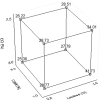Sustainable biosurfactant produced by Serratia marcescens UCP 1549 and its suitability for agricultural and marine bioremediation applications
- PMID: 30609918
- PMCID: PMC6318876
- DOI: 10.1186/s12934-018-1046-0
Sustainable biosurfactant produced by Serratia marcescens UCP 1549 and its suitability for agricultural and marine bioremediation applications
Abstract
Background: Biosurfactants are surface-active agents produced by microorganisms that have higher efficiency and stability, lower toxicity and higher biocompatibility and biodegradability than chemical surfactants. Despite its properties and potential application in a wide range of environmental and industrial processes, biosurfactants are still not cost-competitive when compared to their synthetic counterparts. Cost effective technologies and renewable raw substrates as agro-industrial and regional waste from northeast of Brazil as cassava flour wastewater, supplemented with lactose and corn oil are mainly the chemically media for growing microorganism and in turn the production of the biosurfactant of quality. This study aimed to obtained biosurfactant by Serratia marcescens UCP 1549 containing cassava flour wastewater (CWW), by application of a full-factorial design, as sustainable practices in puts the production process in promising formulation medium. The characterization of the biomolecule was carried out, as well as the determination of its stability and toxicity for cabbage seeds. In addition, its ability to stimulate seed germination for agriculture application and oil spill bioremediation were investigated.
Results: Serratia marcescens showed higher reduction of surface tension (25.92 mN/m) in the new medium containing 0.2% lactose, 6% cassava flour wastewater and 5% corn waste oil, after 72 h of fermentation at 28 °C and 150 rpm. The substrate cassava flour wastewater showed a promising source of nutrients for biosurfactant production. The isolate biosurfactant exhibited a CMC of 1.5% (w/v) and showed an anionic and polymeric structure, confirmed by infrared spectra. The biomolecule demonstrated high stability under different temperatures, salinity and pH values and non-toxicity against to cabbage seeds. Thus, exploring biosurfactant their potential role in seeds germinations and the promotion and agricultural applications was investigated. In addition, the effectiveness of biosurfactant for removal burned motor oil adsorbed in sand was verified.
Conclusions: The use of medium containing CWW not only reduces the cost of process of biosurfactant production, but also the environmental pollution due to the inappropriate disposal of this residue. This fact, added to the high stability and non-toxicity of the biosurfactant produced by S. marcescens UCP 1549, confirms its high environmental compatibility, make it a sustainable biocompound that can be replace chemical surfactants in diverse industries. In addition, the effectiveness of biosurfactant for stimulate seed germination and removing burned motor oil from sand, suggests its suitability for agriculture and bioremediation applications.
Keywords: Biosurfactant; Cassava flour wastewater; Oil removing; Seed germination; Serratia marcescens.
Figures








Similar articles
-
Novel production of biodispersant by Serratia marcescens UCP 1549 in solid-state fermentation and application for oil spill bioremediation.Environ Technol. 2022 Aug;43(19):2956-2967. doi: 10.1080/09593330.2021.1910733. Epub 2021 Apr 11. Environ Technol. 2022. PMID: 33775228
-
Characterization of trehalolipid biosurfactant produced by the novel marine strain Rhodococcus sp. SP1d and its potential for environmental applications.Microb Cell Fact. 2023 Jul 13;22(1):126. doi: 10.1186/s12934-023-02128-9. Microb Cell Fact. 2023. PMID: 37443119 Free PMC article.
-
Production of the biosurfactant serrawettin W1 by Serratia marcescens S-1 improves hydrocarbon degradation.Bioprocess Biosyst Eng. 2021 Dec;44(12):2541-2552. doi: 10.1007/s00449-021-02625-4. Epub 2021 Sep 13. Bioprocess Biosyst Eng. 2021. PMID: 34514513
-
Biosurfactant: A new frontier for greener technology and environmental sustainability.Ecotoxicol Environ Saf. 2019 Nov 30;184:109607. doi: 10.1016/j.ecoenv.2019.109607. Epub 2019 Sep 7. Ecotoxicol Environ Saf. 2019. PMID: 31505408 Review.
-
An Insightful Overview of Microbial Biosurfactant: A Promising Next-Generation Biomolecule for Sustainable Future.J Basic Microbiol. 2024 Sep;64(9):e2300757. doi: 10.1002/jobm.202300757. Epub 2024 Jun 27. J Basic Microbiol. 2024. PMID: 38934506 Review.
Cited by
-
Valorization of frying oil waste for biodetergent production using Serratia marcescens N2 and gamma irradiation assisted biorecovery.Microb Cell Fact. 2022 Jul 30;21(1):151. doi: 10.1186/s12934-022-01877-3. Microb Cell Fact. 2022. PMID: 35907859 Free PMC article.
-
Rhamnolipids Sustain Unchanged Surface Activities during Decomposition in Alkaline Solutions.ACS Omega. 2021 Jun 8;6(24):15750-15755. doi: 10.1021/acsomega.1c01099. eCollection 2021 Jun 22. ACS Omega. 2021. PMID: 34179619 Free PMC article.
-
Structural Diversity of the Lipopeptide Biosurfactant Produced by a Newly Isolated Strain, Geobacillus thermodenitrifcans ME63.ACS Omega. 2023 Jun 6;8(24):22150-22158. doi: 10.1021/acsomega.3c02194. eCollection 2023 Jun 20. ACS Omega. 2023. PMID: 37360472 Free PMC article.
-
Advances on research in the use of agro-industrial waste in biosurfactant production.World J Microbiol Biotechnol. 2019 Oct 1;35(10):155. doi: 10.1007/s11274-019-2729-3. World J Microbiol Biotechnol. 2019. PMID: 31576428 Review.
-
Characterization of a Surface-Active Protein Extracted from a Marine Strain of Penicillium chrysogenum.Int J Mol Sci. 2019 Jul 2;20(13):3242. doi: 10.3390/ijms20133242. Int J Mol Sci. 2019. PMID: 31269636 Free PMC article.
References
-
- Brumano LP, Soler MF, Silva SS. Recent advances in sustainable production and application of biosurfactants in Brazil and Latin America. Ind Biotechnol. 2016 doi: 10.1089/ind.2015.0027. - DOI
-
- Santos APP, Silva MDS, Costa EVL, Rufino RD, Santos VA, Ramos CS, Sarubbo LA, Porto AFL. Production and characterization of a biosurfactant produced by Streptomyces sp. DPUA 1559 isolated from lichens of the Amazon region. Braz J Med Biol Res. 2018 doi: 10.1590/1414-431x20176657. - DOI - PMC - PubMed
-
- Perfumo A, Rudden M, Marchant R, Banat IM. Biodiversity of biosurfactants and roles in enhancing the (bio) availability of hydrophobic substrates. In: Krell T, editor. Cellular ecophysiology of microbe: hydrocarbon and lipid interactions. Handbook of hydrocarbon and lipid microbiology. Springer: Cham; 2018. pp. 75–103.
-
- Shekhar S, Sundaramanickam A, Balasubramanian T. Biosurfactant producing microbes and their potential applications: a review. Crit Rev Environ Sci Technol. 2015 doi: 10.1080/10643389.2014.955631. - DOI
Publication types
MeSH terms
Substances
Grants and funding
LinkOut - more resources
Full Text Sources

